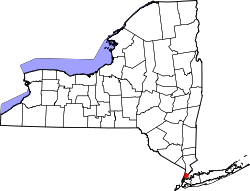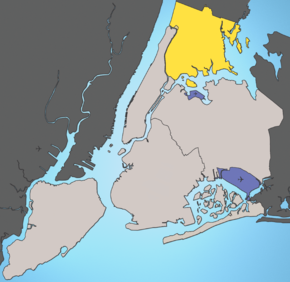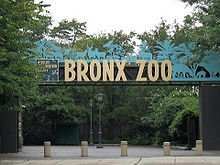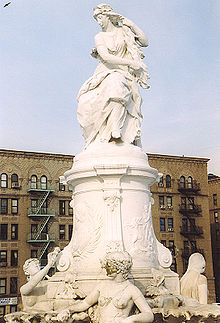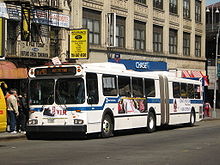Bronx
| administration | |
|---|---|
| US state : | new York |
| Administrative headquarters : | |
| Foundation : | 1639 |
| Demographics | |
| Residents : | 1,385,108 (2010) |
| Population density : | 12,730.8 inhabitants / km 2 |
| geography | |
| Total area : | 148.7 km² |
| Water surface : | 39.9 km² |
| map | |
The Bronx [ bɹɑːŋks ] since January 10, 1874 northernmost district ( Borough ) of the US metropolis New York City . It coincides with Bronx County , the fourth most populous county in the state of New York .
geography
The total area of the Bronx is 148.7 square kilometers; 108.9 square kilometers of this is land and 39.9 square kilometers (around 26 percent) are water.
The Bronx is separated from Bergen County , New Jersey , to the west by the Hudson River , and from Manhattan Island to the southwest by the Harlem River . To the southeast, the East River forms the border with Queens and the Long Island Sound separates the Bronx from Nassau County on Long Island. To the north, the borough is bordered by Westchester County .
The New York borough of Marble Hill is located on the mainland and was treated like part of the Bronx by the United States Postal Service for the distribution of postal codes ( ZIP code ) , but it belongs to Manhattan.
The Bronx River has its source in Westchester County and flows through the borough until it finally flows into the East River. The Hutchinson River runs through the East Bronx and flows into Eastchester Bay .
The Bronx is the only borough of New York City that is almost entirely on the North American mainland. It also includes several small islands in the East River and Long Island Sound.
population
The Bronx has a population of approximately 1.40 million (2009), making it the second smallest of the five New York boroughs after Staten Island . The annual population growth is 0.5 percent (average 2000–2009).
Overall, the population of the Bronx is very multicultural . Due to continued high levels of immigration , 41 percent of all residents are now born outside the United States, with most immigrants from the Dominican Republic , Mexico , Jamaica , Sub-Saharan Africa, and Kosovo . However, if one looks at the various boroughs of the Bronx individually, the composition of the population appears less diverse. Many parts of the city - and even more so the individual blocks - are dominated by certain population groups or groups of origin, which equates to clear ethnic and social segregation . Like many neighborhoods in New York, the city district reflects the history of the various waves of immigration in the city: At the end of the 19th century, numerous Italians and Irish came , at the beginning of the 20th century, Eastern European Jews followed , during the Great Migration in the 1920s, African-Americans came, which soon dominated the district, in the last decades of the 20th century immigrants from Puerto Rico and Latin America .
Hispanics make up the majority of the Bronx with a share of 52 percent. Puerto Ricans make up the largest group of origin with a share of 23 percent, a further 16 percent are Dominicans and 5 percent are Mexicans. Afro-Americans and immigrants from the Caribbean and Africa make up the second large population group at 31 percent. Among the non-Hispanic whites, who make up only a relatively small minority with a share of 12 percent of the total population, Italians and Irish are by far the largest groups. Regardless of national origin, around half of whites identify as Jews . Besides these and a small Protestant minority, most of the residents are Catholics . In the Bronx, Spanish (46 percent) and English (44 percent) are spoken approximately equally .
history

In 1639, the Swedish-born settler Jonas Bronck (* around 1600, † 1643) was the first European to settle with his family in what is now the Bronx. Subsequent Dutch and English settlers soon referred to the land he had acquired in the area as “Bronck's Land” and to announce a visit there, they said at the time: “We are going to the Bronck’s ”. The current spelling of the name was first used in 1874 when the area that was originally part of Westchester County was made a separate district; the preceding article was retained.
Especially in the years after 1900, the area was rapidly urbanized and built on and experienced its first economic peak. After the Great Depression , the Bronx was a middle-class home in the 1940s . However, in the period after the Second World War, more and more of the former residents of European descent (see above) moved away and the Bronx became a working class and poor district.
From the 1960s onwards, the Bronx was best known worldwide for being a socially hotspot with a high crime rate. Gang crime, car theft, drugs and robbery were commonplace during the day at least in the southern part of the Bronx (South Bronx). As in the entire city of New York, crime in the Bronx also fell significantly from the 1990s, so that the conditions of the 1970s and 1980s are largely a thing of the past. The number of crimes committed in the Bronx decreased by 73 percent from 1990 to 2007, the number of robberies per day dropped from 49 to 13. Little is known that the Bronx borough is not only cheap rented houses and public housing but also residential areas Middle class like Spuyten Duyvil . Still, only around 20 percent of households in the Bronx are home, an extremely low figure for the United States. The Bronx can be described as a “ dormitory city ” for Manhattan, because with a population of over 1.3 million it only has around 220,000 jobs, but at the same time 87,000 one-person companies.
The 2017 Bronx fire caused twelve deaths.
Historical objects

Off US Highway 1 is the Lorillard Snuff Mill (also known as the Old Snuff Mill). The historic snuff mill was listed on December 22, 1977 by the National Register of Historic Places as a monument with the number 77000935 and is recognized as a National Historic Landmark .
Eight locations have the status of a National Historic Landmark . A total of 66 buildings and sites in the county are listed on the National Register of Historic Places (as of February 17, 2018).
Culture
The origins of hip-hop and breakdance developed here in the late 1960s due to the Afro-American and Puerto American population . The area around Yankee Stadium is characterized by the numerous Hispanic restaurants, where you can find specialties from the Caribbean , for example the popular mofongos , a type of large dumpling that can also be filled with meat.
There are plenty of cheap shopping opportunities in the Bronx, including Fordham Road , which stretches across the Bronx.
The Bronx is also a very popular filming location for the American film industry . More than 80 films have been made there since the 1950s, including The Wanderers .
Sports
The most famous sports venue of the Bronx is located at 161st Street Yankee Stadium , where regular baseball games of the New York Yankees and football games of the New York City FC will be played.
Attractions
Bronx Zoo
The Bronx Zoo , with its full name "International Wildlife Conservation Park", is a zoological garden in New York . The zoo was founded in 1899. With over 300 hectares, it is the largest zoo in New York and the largest city zoo in the United States. The New York Botanical Garden , which connects to the north , is also part of the zoo .
More than 4,300 animals of 765 different species live in the park. The division was made according to geographical aspects. If a clockwise tour starts at the Rainey Gate Entrance in the north, visitors roam the following continents: North America , Asia , Africa and South America . The Bronx Zoo has many species of animals that have become extinct in the wild.
Heinrich Heine Monument
The Heinrich Heine monument , in English as Lorelei Fountain called, is made of white Laas designed marble fountain to the memory of the German poet and writer Heinrich Heine dedicated. The memorial was originally intended to be erected in Heine's hometown of Düsseldorf. However, the anti-Semitic and nationalist agitation in the German Reich prevented the monument on Heine's 100th birthday from being completed and inaugurated in 1897. Instead, it was unveiled on July 8, 1899, in the presence of the sculptor Ernst Herter in the Bronx, New York. The memorial stands at the south end of Joyce Kilmer Park at 161st Street and Grand Concourse across from a District Court.
Poe Cottage
Edgar Allan Poe's last home is now a restored and generally accessible museum. He lived in what was then the suburb of Fordham from 1846 to 1849. His wife and cousin Virginia Clemm Poe , the model of his Annabel Lee, died here . Poe Cottage was moved 140 meters from its original location in 1913. It is across from Poe Park on Kingsbridge Road in the Bronx.
Grand Concourse
The numerous Art Deco buildings along the Grand Concourse are interesting for architecture enthusiasts . This north-south main connection, based on the Parisian model of the Champs-Élysées , was tunnelled by a subway (“Concourse Line”) in the 1920s and 1930s, followed by a construction boom in the Art Deco and Streamline Modern styles. In addition to theaters, hotels and public buildings (courthouses), a. countless elegant houses.
More parks
- Bronx park
- Crotona Park
- Woodlawn Cemetery
- Pelham Bay Park
- Saint Raymonds Cemetery
- Van Cortlandt Park
- Wave Hill
Economy and Infrastructure
economy
The Bronx is one of the structurally weak counties in the United States. The annual per capita income of 17,464 US dollars is well below the national average of 27,466 US dollars. The unemployment rate is at 10.3 percent was also significantly higher than in the United States as a whole (6.4 percent). The proportion of people living below the poverty line in the Bronx is 27.8 percent, more than twice the American average (13.2 percent). In addition, prosperity is very unevenly distributed among the various population groups.
→ For more information on the economic situation of the population groups see: Demographics of the Bronx
traffic
The Bronx is crossed by lines 1, 2, 4, 5, 6, B and D of the New York subway in a north-south direction and is thus connected to Manhattan located to the south . Most of the subway runs in the Bronx as an elevated train. Depending on which of the total of 71 subway stations in the Bronx you start from, Midtown Manhattan can be reached in about 30 to 40 minutes. The northern line endpoints are up to 20 kilometers from Midtown Manhattan. Some lines run in sections as express and pass through numerous train stations in order to keep travel times to the city center as short as possible. The subway runs around the clock. East-west connections within the Bronx are served by numerous city bus routes.
Districts
The borough of The Bronx is divided into 12 community districts, which in turn are divided into 59 districts (neighborhoods).
See: Administrative Divisions of New York City
Borough Presidents
The Borough President has been the elected head of the borough since 1898:
- 1898–1909 Louis F. Haffen
- 1909-1910 John F. Murray
- 1910-1914 Cyrus C. Miller
- 1914-1918 Douglas Mathewson
- 1918–1934 Henry Bruckner
- 1934-1962 James J. Lyons
- 1962–1966 Joseph F. Periconi
- 1966-1970 Herman Badillo
- 1970–1979 Robert Abrams
- 1979-1987 Stanley Simon
- 1987-2002 Fernando Ferrer
- 2002-2009 Adolfo Carrión
- since 2009 Ruben Diaz Jr.
Personalities
Many celebrities were born and / or raised in the Bronx. One of the most famous examples of this is the Puerto Rican singer Jennifer Lopez , who talks about her childhood in the South Bronx in her song Jenny from the Block . Her album On The Six is named after the train on Line 6 that drives to her home district of Parkchester , a symmetrical, high-rise housing estate. Other examples are the rapper Fat Joe and the Hispanic boy band Aventura , which landed a number one hit in Europe with their title Obsesión . The following personalities also come from the Bronx:
- Ace Frehley
- Al Pacino
- Alan Heim
- Alan Merrill
- Amy Heckerling
- Angela Bofill
- Anne Bancroft
- Arthur Bisguier
- Robert Anthony Brucato
- Anthony Francis Mestice
- Kind Donovan
- Arthur Ripley
- Barbara Rosenthal
- Bella trigger
- Bess Myerson
- Big Punisher
- Bill Polian
- Billy Joel
- Bruce Altman
- Bruce Harris
- Buddy Arnold
- Calvin Klein
- Cara Buono
- Carl Reiner
- Carroll O'Connor
- Chaim Potok
- Chris Mondt
- Christopher Aponte
- Colin Powell
- Cuba Gooding Jr.
- Cus D'Amato
- Damaine Radcliff
- Daniel Libeskind
- Dava Sobel
- Denzel Washington
- Diahann Carroll
- Diane Lampert
- Dion DiMucci
- Dick Miller
- Dolores Hope
- Don DeLillo
- Don Kirshner
- Dutch Schultz
- EL Doctorow
- Edward Koch
- Fat Joe
- Fiorello LaGuardia
- Frank Lovejoy
- Fred C. Trump
- Fred Weintraub
- Freddie Gruber
- Gabriel Macht
- Garry Marshall
- Grace Paley
- Grandmaster Caz
- Grandmaster Flash
- Grand Wizard Theodore
- Gray Davis
- Gregory Masurovsky
- Hank Greenberg
- Harold Sanford Kant
- Herbert Pointer
- Inspectah deck
- Ira Levin
- Jake LaMotta
- James Caan
- Jennifer Lopez
- Jerry Orbach
- Joe Venuto
- Joey Archer
- Joey Bishop
- John Berry
- John Erskine
- John Fedorowicz
- John B. Williams
- Joseph O'Hare
- Joy Bryant
- Judy Reyes
- June Allyson
- Kalil Madi
- Kat DeLuna
- Keith Tapia
- Kool DJ Herc
- KRS-One
- Larry Ellison
- Larry Tesler
- Laura Nyro
- Linda Lovelace
- Lloyd C. Blankfein
- Lord finesse
- Mae Questel
- Madeline Lee Gilford
- Marilyn Hacker
- Martin Balsam
- Marty Glickman
- Mary Higgins Clark
- Mary J. Blige
- Margaret Bourke-White
- Max Desfor
- Max J. Rosenberg
- Max Kellerman
- Melle Mel
- Michael Landes
- Morty ghost
- Murray Rothbard
- Natalie Angier
- Nate Archibald
- Neil Simon
- Nestor Serrano
- Orrin Keepnews
- Paddy Chayefsky
- Parris Glendening
- Paul button
- Penny Marshall
- Percee P
- Phil Spector
- Philip Zimbardo
- Ralph Lauren
- Ray Mantilla
- Rebel aka Unikkatil
- Richard Price
- Regina Spektor
- Regis Philbin
- Reuben Hersh
- Rob Reiner
- Robert Gossett
- Roberta Peters
- Ron Galella
- Sal Mineo
- Saquon Barkley
- Showbiz and AG
- Sonia Manzano
- Stan Getz
- Stanley Kubrick
- Stephen Balzer
- Sylvia Sidney
- Tanya Roberts
- Tim Dog
- T La Rock
- Tony Curtis
- Tyler Alvarez
- Tyson Beckford
- Vince Gironda
- Will Calhoun
- William Parker
- William Lewis Safire
- Yehudi Menuhin
Individual evidence
- ↑ US Census Bureau 2008
- ↑ GNIS-ID: 974101. Retrieved on February 22, 2011 (English).
- ↑ US Census Bureau: Population Finder , accessed October 28, 2010
- ↑ Bronx Chronology ( Memento of the original from July 27, 2015 in the Internet Archive ) Info: The archive link was inserted automatically and has not yet been checked. Please check the original and archive link according to the instructions and then remove this notice. Bronx Historical Society, accessed December 28, 2012. (English)
- ↑ NYPD crime statistics for the Bronx district ( Memento of the original from January 17, 2009 in the Internet Archive ) Info: The archive link was inserted automatically and has not yet been checked. Please check the original and archive link according to the instructions and then remove this notice. (PDF; 104 kB)
- ↑ a b General Statistics from the US Census Bureau on the Bronx County
- ↑ NRIS
- ↑ National Historic Landmarks Program (Lorillard Snuff Mill) ( Memento of the original from June 5, 2011 in the Internet Archive ) Info: The archive link was inserted automatically and has not yet been checked. Please check the original and archive link according to the instructions and then remove this notice.
- ↑ Listing of National Historic Landmarks by State: New York . National Park Service , accessed February 17, 2018.
- ↑ Search mask database in the National Register Information System. National Park Service , accessed February 17, 2018.
- ↑ Blog from the Bronx on the subject of Art Déco ( Memento of the original from December 11, 2008 in the Internet Archive ) Info: The archive link was inserted automatically and has not yet been checked. Please check the original and archive link according to the instructions and then remove this notice.
- ^ Rulers.org: New York City boroughs
Web links
Coordinates: 40 ° 50 ′ N , 73 ° 53 ′ W
